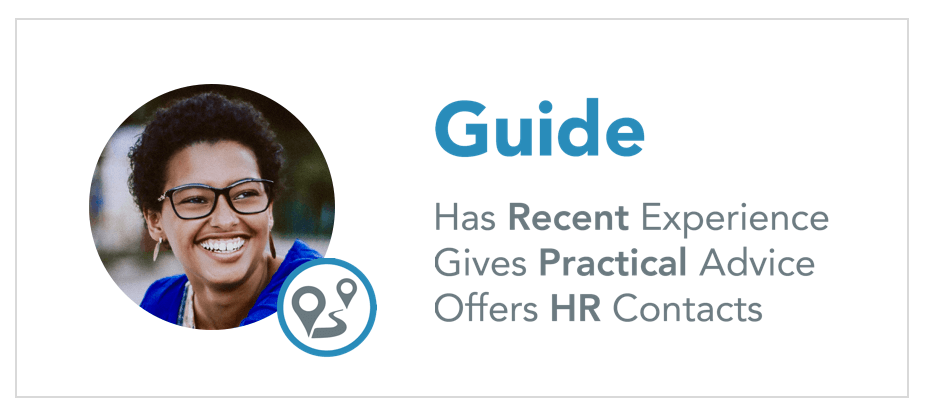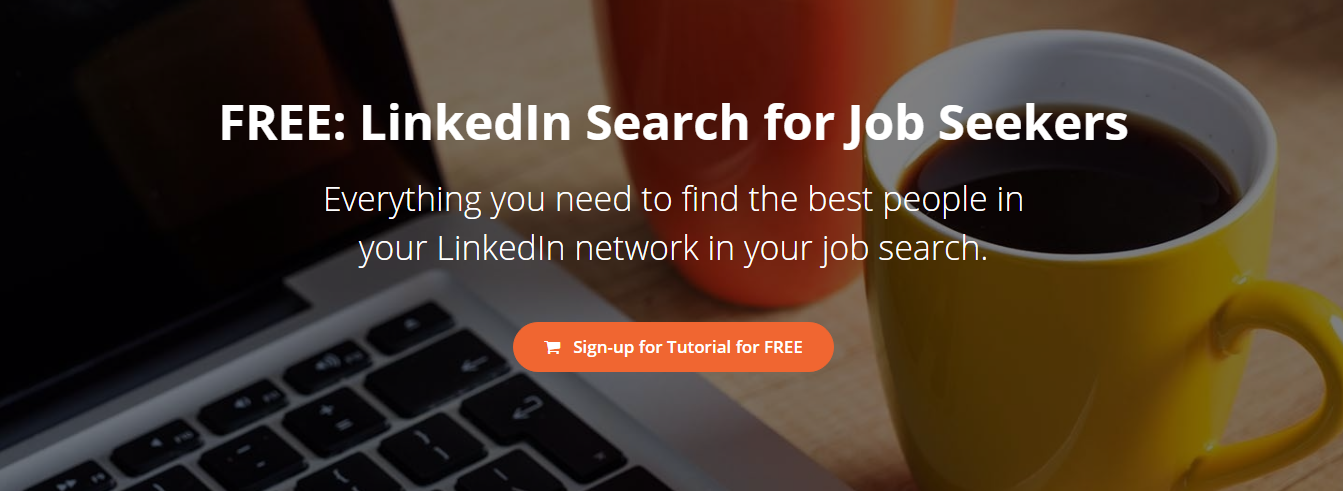
The real power of LinkedIn is not in the job postings—it’s in your network. Since 85% of jobs aren’t posted online, networking will drastically boost the odds that you’ll find a job you love. Plus, networking can lead to referrals, which can increase your chances of landing the job 10x over.
Yet, casting a wide net and reaching out to random people won’t get you there.
To find the right job, you need to be reaching out to the right people in your network. You want to make sure you’re being strategic with who you reach out to. With so many options and so little time and energy, you want to make sure you’re choosing among your contacts wisely.
But who are the right people, and how do you find them?
Most people underestimate the size and quality of their network. Today, your LinkedIn network likely contains tens of thousands of people. For example, if you have around one hundred 1st-degree connections, you’ll likely have access to a personal network of more than 20,000 people.
Here’s five steps to finding the connections that can help you land your dream job:
1. Outline the information you need from your network

Not all connections in your network are the same. Not only are different people in your network from different industries, but they are also at different stages in their careers. Connections in your network will have different experiences to share.
That’s why it’s important to take a targeted approach. Before you reach out to anyone, know what you’re looking for. If you’re looking for a new job, you’ll likely need:
- Specifics about the job role
- An understanding of the skills or experience required for a job
- Details on the hiring process
- Information on the organization’s culture
- Referrals
- HR contacts
Having a clear sense of what you need helps you to zero in on your specific contacts who have the right experience. You’ll be saving both yourself and your contact time and effort by outlining what you need first.
2. Understand what “Guides” are, and how they can help in your job search

It’s a myth that you need to reach high up the ladder to find strong referrals and powerful connections.
In fact, senior-level people are less likely to be able to answer any of the practical questions you have. They are harder to reach, more intimidating to talk to, and won’t be able to provide you as much value as you hoped.
They’ll be less in touch with the day-to-day details of both the job itself and the hiring process. If your goal is to find and land a job that’s a great fit for you, don’t bother reaching out to upper level execs and senior management.
To find your dream job, the best people to network with are those just a few steps ahead of you on your desired career path.
We call these people “Guides,” one of our four Connection Types based off of our research. While different Connection Types offer different types of advice, Guides are the most beneficial connections when you’re in your job search.

Because of their recent experience, Guides can anticipate your questions before you even ask them.
Guides can offer practical advice on your application, details of the job and hiring process, and HR contacts. Even better, Guides are in a position to provide strong referrals for jobs they recently held. This is why people close to you in experience are best positioned to help you.
Put simply: Guides know what it’s like to be in your shoes. They were in your position not too long ago themselves.
If you are looking for a new job and a great fit, these are the best people in your network to talk to. They are also the most overlooked and underutilized resources in professional networks.
3. Ask friends and family for specific Guide recommendations
Now, you know what questions you need answered and what type of people will be most helpful—but how do you find them?
Always start by asking your family and friends for Guide recommendations. Contacts you get through people you know well are more responsive than those you find through more tertiary means.
Avoid getting referred to the wrong Connection Type
Be forewarned: make sure you are specific when you explain to friends and family what type of person you’re looking for. If you don’t, you risk meeting with the wrong Connection Type.

For instance, people may offer to connect you with the most senior people in their network. Parents are especially apt to connect you to their “friends in high places.” Remember that seniority no longer equates to hiring influence. So, steer people away from their most senior contacts.
For instance: Take Audrey, who now works in innovation for a large company. She laughs when recalling her own debacle.
When Audrey was a junior in college, she told her mother—an attorney—that she was considering law school. Thrilled by Audrey’s interest, her mother offered to connect her with a friend.
Who was that friend?
A Supreme Court Justice for Washington State. No big deal, right?
Wrong. Not only was this highly intimidating for Audrey, it was disappointing for both of them since they had little to talk about. The justice was too far removed from Audrey’s situation to offer any relevant advice for her situation. Talk about awkward.
How do you prevent getting connected with the wrong people? Get specific.
Provide a few Guide descriptors about who you’re looking for when you ask for recommendations. This helps to ensure you end up talking to Guides, who can actually help in your job search.

For example when asking for an introduction to a Guide: Don’t say, “Do you know anyone who works in data analytics?”
Instead, say: “I’d really like to talk to someone who is a data analyst working in a healthcare company to get a sense of the job opportunities available and the hiring process at their company. Ideally, this person would have started in the last five years, and is still working in data analytics.”
If you get some ideas from others, verify those contacts have the relevant experience you are looking for before getting introduced.
Ask your friend a few clarifying questions about their recommended contact and scan the contact’s LinkedIn profile. Do this before committing to contact them to save everyone from an awkward meetup.
It’s worth the extra step to qualify any recommendations. It ensures you focus your effort on the people that can help you, and avoid wasting energy on those who can’t.
4. Search LinkedIn for the Guides in your area of interest
LinkedIn is the most comprehensive professional network, with over 500 million LinkedIn users. People tend to keep their LinkedIn profiles up to date, so it’s a good resource for finding and researching contacts when you’re looking for a job. Yet, when people are looking for jobs, they don’t know how to find the best people to talk to among the thousands of search results.
When you’re looking for Guides, look for people who are a few steps ahead of you, working in your desired field. They’re often 2nd-degree connections who you may be familiar with, but have overlooked.
If you could use some guidance on leveraging your LinkedIn network during your job search, we’ve got you covered. Use this free LinkedIn Search for Job Seekers Course to quickly find 3 to 5 Guides in your LinkedIn network.
5. Start networking with Guides to find your dream job
Once you’ve found some Guides that are a few steps ahead of you professionally, it’s time to reach out for a conversation. Informational interviews with Guides can lead you down many paths: to a job that’s not posted online, a referral, insider advice on the hiring process, information on the company culture, and even introductions to other Guides.
Reaching out to someone you don’t know or haven’t talked to in awhile can be nerve-wracking. Generic email templates don’t make the best first impression, especially if your contact has seen the email template before! But writing outreach emails from scratch sounds too difficult.
That’s where MANGO can help.
Try using MANGO’s FREE Conversation Request Email Builder, a tool that guides you step-by-step through writing outreach emails. This Email Builder will ensure you have a polished, professional email to send, without the risk of using a generic email template.
The most successful job seekers don’t get there alone. Your network is filled with people who can (and want to!) help you move forward, just like they did.
Don’t put it off any longer. Take that first step towards scoring a job you look forward to every morning. Start writing your conversation request email today.
Can we send you a useful email?
More articles like this one, tips you can really use, and advice that makes your next career move easier.
Sue Wollan Fan is the Founder & CEO of MANGO, a free networking tool whose mission is to expand opportunities for all by making networking easier, accessible, and more human. She has mentored hundreds to succeed professionally while serving as a corporate executive, nonprofit leader, tech entrepreneur, and mother of three. She is passionate about helping others do work that matters.
